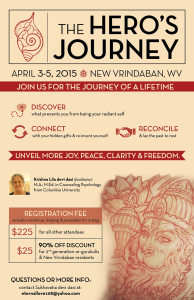The post March 30th, 2015 – Darshan appeared first on Mayapur.com.
March 30th, 2015 – Darshan
HG Murli Manohara Dasa – SB 10.82.3-16 – 19.03.2015
→ Gouranga TV - The Hare Krishna video collection
HG Murli Manohara Dasa – SB 10.82.3-16 – 19.03.2015
HH Giriraj Swami / SB 2.3.23 – Sunday Feast
→ Kalachandji's Audio Archive
Ramayana – The Full Movie
→ ISKCON News
GBC College – First Residential Session Completed
→ ISKCON News

The first ISKCON GBC college for leadesrsip and management held at Govardhan Ecovillage, Maharastra, India was a great success. “It’s been a life-changing experience to attend these GBC College sessions,” said Gauranga Simha Das, Co-director for ISKCON Mayapur. “This training has motivated me in such a way that I want to rededicate myself to serving the movement of Srila Prabhupada with more seriousness and vigor.
The age of forgiveness
→ KKSBlog
(Kadamba Kanana Swami, 02 January 2015, Simhachalam, Germany, Caitanya Caritamrta Antya 7.16)
 We must not blindly follow but always use our intelligence to deeply understand our philosophy and all the stories from the different ages. In previous ages, quite outstanding things were possible. In those times, sages had amazing powers and piety was a big thing.
We must not blindly follow but always use our intelligence to deeply understand our philosophy and all the stories from the different ages. In previous ages, quite outstanding things were possible. In those times, sages had amazing powers and piety was a big thing.
But now, we live in a different age. The first principle of this age is forgiveness, ksama; that is the essence. If there is no forgiveness – forget it! If you cannot forgive then you cannot be a devotee, as it is not going to work that way. So many people do things to us and sooner or later, it is a devotee. Have you thought about the things that devotees have done to you? Devotees, you know, tilak and neckbeads, how they have treated us sometimes!? But forgiveness is required because how can we live amongst the vaisnavas without forgiveness? How can we preach without forgiveness? The fact is that everyone is so sinful, so fallen, so learning to forgive is a very deep thing.
In Srimad Bhagavatam, Bhismadev says that to conquer anger one must learn to forgive, as without forgiving, some anger remains. There are different types of anger – first there is a hot anger, the fist on the table type, ‘And now, it is enough!!’ Then there is the other anger, the cold one, where the heart freezes and one says, ‘For that one, there is no mercy!’ Ice-cold anger in a frozen heart.
So we need to see others through our own example and ask ourselves who is actually perfect amongst us, who has never made a mistake? Who has not done anything wrong to anybody? If there is an angel amongst us, please show us your wings! So we can see it is not that feasible. Therefore, if we approach others through our own life and through how we have dealt with others, then it is easier to forgive.
We are filled with weaknesses, so to forgive means to accept weakness in others, that they make mistakes and that they are not perfect. It is actually to be expected in this age of kali because in this age, weakness of character is our biggest problem. We are weak – we have no determination, we have no piety, we are proud, we cannot tolerate very much, we are lazy and we do not want to work very hard, we are not very learned but at the same time, we think that we know everything.
These are all the typical things that everybody has – everybody! It is not that somebody is different, but everybody thinks, ‘I know very well! Why they are telling me this, when I already know it? What can I do, when Krsna gave it to me, to know things!’ The root cause of our material disease is manifested in thinking, ‘I know!’ Because we think that way, it becomes such a habit to just do our own thing and not accept a proper guidance.
Produces More Good Chanting
→ Japa Group
Naam Ramayana 13 – The Lord’s mercy doesn’t leave anyone out
→ The Spiritual Scientist
Naam Ramayana Podcast
Download by "right-click and save content"
Gita 06.25 – Don’t expect overnight change – determinedly make gradual changes
→ The Spiritual Scientist
Gita daily Podcast
Download by "right-click and save content"
Bhagavatam-daily 164 – 11.10.06 – Let speech elevate, not downgrade, consciousness
→ The Spiritual Scientist
Bhagavatam-daily Podcast:
Download by "right-click and save content"
Nitai Gauranga Harinama Yatra Sankirtana Presentation (25 min…
→ Dandavats.com

Nitai Gauranga Harinama Yatra Sankirtana Presentation (25 min video)
Srila Prabhupada: The process of chanting the holy name of the Lord is always superbly effective, but it is especially effective in this age of Kali. All the great authorities of bhakti-yoga recommend the devotional process beginning with the chanting of the holy name of Krishna (tan-nama-grahanadibhih).
(Srimad-Bhagavatam, 6.1.21 Purport)
Watch it here: http://goo.gl/8LAeYm
Krishna is Hungry for His Devotee’s Love, March 26, Dallas
Giriraj Swami
 Giriraj Swami read and spoke from Srimad-Bhagavatam 10.81 6-7.
Giriraj Swami read and spoke from Srimad-Bhagavatam 10.81 6-7.
“Duryodhana was affronted that Krishna did not accept his invitation to enjoy a royal banquet with him. So, Krishna explained to him. ‘There are only two reasons to accept an invitation to eat. One is if you are hungry, and the other is if the invitation is extended with love. I was not hungry and you have no love for me so I would not come for that reason either. Therefore I did not accept your invitation. But even though Krishna was not hungry—and in a sense He is never materially hungry—Krishna was hungry for His devotee’s love. And that love was offered to Him through the banana peels He ate from Vidura. And so He relished that offering of love.”
H.G.Ridha Prabhu sharing Prabhupada memories (10 min…
→ Dandavats.com
HH Giriraj Swami / CC Madhya 8.90
→ Kalachandji's Audio Archive
Sri Rama Navami Photos _ ISKCON SALEM (Album with 66 photos)
See…
→ Dandavats.com
Hare Krishna! Hema Malibu to be the Chairman for Next Year’s…
→ Dandavats.com

Hare Krishna! Hema Malibu to be the Chairman for Next Year’s ISKCON’s 50th Anniversary
This evening, March 29th, 2015, MP Ms. Hema Malibu Visited ISKCON Vrindavan. HH Gopal Krishna Maharaj, HG Panchgauda and HG Deena Bandhu Das greeted her in Temple. She has a deep affection for Krishna Balaram. She ate Krishna Balaram’s Prasad with deep interest which was given to her by and HH Gopal Krishna Maharaj requested her to be the Chairman for Next Years ISKCON’s 50th Anniversary, She Readily accepted it.
Read the entire article here: http://www.dandavats.com/?p=16503
Sadhu Feast in Sri Krishna Balaram Mandir (Album with photos)
On…
→ Dandavats.com

Sadhu Feast in Sri Krishna Balaram Mandir (Album with photos)
On the day after Rama Naumi, we fed all the 250 Vaishnava Mahants of Vrindavan. First came 11 flags of some of the Akharas with the emblem of Hanuman. We garlanded the flags and then offered the prasad to Hanuman. Then all the mahants arrived and very happily took prasad in our Krishna Hall!
See them here: http://goo.gl/uh1xWe
Hare Krishna! Bhaktivedanta Institute – Atlanta…
→ Dandavats.com

Hare Krishna! Bhaktivedanta Institute – Atlanta Conference
Conference Theme: “The Science of Ethics and Values across Borders”
Read the entire article here: http://www.dandavats.com/?p=16497
Hare Krishna! Looking for Admin Assistant, Foreign Registration…
→ Dandavats.com

Hare Krishna! Looking for Admin Assistant, Foreign Registration Office Mayapur
1) Job title : Admin Assistant FRO (Foreign Registration Office)(Male)
Job location: FRO (Foreign Registration Office), No. 104, General Manager Room, Long building
Main responsibilities :
* One must be able to speak English & Russian language to communicate with devotees to know their requirement.
* Basic computer knowledge to fill required forms & draft letters.
* Will have to travel to Kolkata once in a week on office duty.
Required level of education: Preferably a Graduate.
Read the entire article here: http://www.dandavats.com/?p=16494
More stories by Srutakirti Prabhu about the early days of…
→ Dandavats.com

More stories by Srutakirti Prabhu about the early days of Krishna Balaram Mandir (60 min video)
Watch it here: http://goo.gl/fxRciX
Navadwipa Mandala Parikram (Album 199 photos)
Srila Prabhupada:…
→ Dandavats.com

Navadwipa Mandala Parikram (Album 199 photos)
Srila Prabhupada: The process of chanting the holy name of the Lord is always superbly effective, but it is especially effective in this age of Kali. All the great authorities of bhakti-yoga recommend the devotional process beginning with the chanting of the holy name of Krishna (tan-nama-grahanadibhih).
(Srimad-Bhagavatam, 6.1.21 Purport)
See them here: http://goo.gl/B4LUp7
An anecdote about Srila Prabhupada from this morning’s Bhagavatam class
→ SivaramaSwami.com
The post An anecdote about Srila Prabhupada from this morning’s Bhagavatam class appeared first on SivaramaSwami.com.
Riverhead, New Zealand: Kirtana forever! (Album 22 photos)
Srila…
→ Dandavats.com

Riverhead, New Zealand: Kirtana forever! (Album 22 photos)
Srila Prabhupada: One should be a devotee and surrender to the lotus feet of Krishna. This surrendering process is also very easy. Even a child can perform it. One must always simply think of Krishna by chanting Hare Krishna.
(Srimad-Bhagavatam, 5.226.37 Purport)
See them here: http://goo.gl/rTR5dZ
Hare Krishna! Art on the Wall with Kardami
Once I had to do a…
→ Dandavats.com

Hare Krishna! Art on the Wall with Kardami
Once I had to do a painting for an ISKCON center in Bulgaria. It was a picture of Radha and Krishna appearing from both sides of the altar. I decided to start with Krishna. When the time came to start painting the portrait of Srimati Radharani, I was in this mood that I could do anything very easily, without making an effort. I thought I would paint her in a day. Haha- big mistake. The first time I painted her, it didn’t work. I painted her again, and it didn’t work either. I tried once more, completely disheartened, and again it didn’t work. I felt useless…
Read the entire article here: http://www.dandavats.com/?p=16491
Hare Krishna! Devotion is not just a calling – it is also a…
→ Dandavats.com

Hare Krishna! Devotion is not just a calling – it is also a choice
Many people treat devotion as a calling to which some are called and some (they) aren’t. Thus, they rationalize delaying their practice of devotion till some uncertain future when they will feel the call. It’s true that many great saints had life-defining moments of calling – moments that folk narratives about them glamorize. But such narratives often neglect the reality that those saints’ devotion was not just a calling but also a choice, a choice they resolutely exercised lifelong.
Read the entire article here: http://www.dandavats.com/?p=16488
Sydney Ratha Yatra 2015 (Album 198 photos)
Srila Prabhupada:…
→ Dandavats.com

Sydney Ratha Yatra 2015 (Album 198 photos)
Srila Prabhupada: This Krishna consciousness movement insists that everyone take to this path by adopting the chanting of the Hare Krishna maha-mantra. The preachers of Krishna consciousness go from door to door to inform people how they can be relieved from the miserable conditions of material life.
(Srimad-Bhagavatam, 5.14.39 Purport)
See them here: http://goo.gl/UTFWAE
Hare Krishna! Official communication of the GBC about the…
→ Dandavats.com

Hare Krishna! Official communication of the GBC about the Krishna West preaching program
Dear Members of ISKCON, Please accept our humble obeisances. All glories to Srila Prabhupada. The GBC Executive Committee (EC) has been in communication with Hridayananda Das Goswami for over a year, seeking to understand better how his preaching program, Krishna West, will function within ISKCON. The GBC Body through the agency of its Organizational Development Committee is developing a configuration of ISKCON and its affiliates for a better understanding of their specific functions and position in the society of devotees.
Read the entire article here: http://www.dandavats.com/?p=16484
22.03.2015 H.G.Prabhavishnu Prabhu-5.18.29
→ Gouranga TV - The Hare Krishna video collection
22.03.2015 H.G.Prabhavishnu Prabhu-5.18.29
New Vrindaban Hosts Special “Hero’s Journey” Seminar
→ New Vrindaban Brijabasi Spirit
HH Giriraj Swami / Rama Navami – The Appearance of Lord Ramachandra / Evening class
→ Kalachandji's Audio Archive
TOVP Tour Diary Day 13 – Arrival at ISKCON Philadelphia, New Nilacala
- TOVP.org
On the morning of Tuesday, March 24th we set out by car on a 7 hour drive to our next destination, Philadelphia, Pennsylvania.
Although not the original temple in Philadelphia, the Hare Krishna movement has been present there since Srila Prabhupada’s time. We arrived around 7pm in the evening greeted by kirtan and discussed our plans for the next 4 days with Temple President Sikhi Mahiti das, a senior disciple of Srila Prabhupada.
The post TOVP Tour Diary Day 13 – Arrival at ISKCON Philadelphia, New Nilacala appeared first on Temple of the Vedic Planetarium.
Gita 06.24 – Determination means rejection of dejection
→ The Spiritual Scientist
Gita Verse-by-verse Study Podcast:
Download by "right-click and save content"
Bhagavatam-daily 163 – 11.10.05 – The purpose of sadhana is the change of desires
→ The Spiritual Scientist
Bhagavatam-daily Podcast:
Download by "right-click and save content"
HH Giriraj Swami / Rama Navami – The Appearance of Lord Ramachandra / SB 9.10.20
→ Kalachandji's Audio Archive
The Mood Of Chanting
→ Japa Group
Taken from Art of Chanting Hare Krsna
by Mahanidhi Swami
Sri Rama-navami, March 28
Giriraj Swami
 Today is Sri Rama-navami, the appearance day of the Personality of Godhead Ramacandra. It is also the fortieth anniversary of the opening of Srila Prabhupada’s Krsna-Balarama temple in Vrindavan.
Today is Sri Rama-navami, the appearance day of the Personality of Godhead Ramacandra. It is also the fortieth anniversary of the opening of Srila Prabhupada’s Krsna-Balarama temple in Vrindavan.
In his purport to Sri Caitanya-caritamrta Madhya-lila 16.281, Srila Prabhupada explained why he established the temple.
“Sri Caitanya Mahaprabhu personally renovated Vrndavana-dhama and advised His chief disciples, Rupa and Sanatana, to develop it and open it to attract the spiritual vision of the general populace. At present there are about five thousand temples in Vrndavana, and still our society, the International Society for Krishna Consciousness, is constructing a huge, magnificent temple for the worship of Lord Krsna and Lord Balarama, along with Radha-Krsna and Guru-Gauranga. Since there is no prominent Krsna-Balarama temple in Vrndavana, we are attempting to construct one so that people will be attracted to Krsna-Balarama, or Nitai-Gauracandra. Vrajendra-nandana yei, saci suta haila sei. Narottama dasa Thakura says that Balarama and the son of Maharaja Nanda have advented Themselves as Gaura-Nitai. To propagate this fundamental principle, we are establishing a Krsna-Balarama temple to broadcast to the world that worship of Gaura-Nitai is the same as worship of Krsna-Balarama.
“Although it is very difficult to enter into the Radha-Krsna pastimes, most of the devotees of Vrndavana are attracted to the radha-krsna-lila. However, since Nitai-Gauracandra are direct incarnations of Balarama and Krsna, we can be directly in touch with Lord Balarama and Lord Krsna through Sri Caitanya Mahaprabhu and Nityananda Prabhu. Those who are highly elevated in Krsna consciousness can enter into the pastimes of Radha-Krsna through the mercy of Sri Caitanya Mahaprabhu. It is said, sri-krsna-caitanya radha-krsna
nahe anya: ‘Sri Krsna Caitanya Mahaprabhu is a combination of Radha and Krsna.’ ”
Srila Prabhupada also explained how he organized the installation ceremony and how he wanted the activities to be continued.
“Recently, when we established a large Krsna-Balarama temple in Vrndavana, we were obliged to have Vedic ceremonies enacted by brahmanas because the inhabitants of Vrndavana, especially the smarta-brahmanas, would not accept Europeans and Americans as bona fide brahmanas. Thus we had to engage brahmanas to perform costly yajnas. In spite of these yajnas, the members of our Society performed sankirtana loudly with mrdangas, and I considered the sankirtana more important than the Vedic ritualistic ceremonies. Both the ceremonies and the sankirtana were going on simultaneously. The ceremonies were meant for persons interested in Vedic rituals for elevation to heavenly planets (jadi-krta-matir madhu-puspitayam), whereas the sankirtana was meant for pure devotees interested in pleasing the Supreme Personality of Godhead. We would simply have performed sankirtana, but then the inhabitants of Vrndavana would not have taken the installation ceremony seriously. . . .
“Especially in this age of Kali, sankirtana alone is sufficient. If the members of our temples in the different parts of the world simply continue sankirtana before the Deity, especially before Sri Caitanya Mahaprabhu, they will remain perfect. There is no need of any other performances. Nevertheless, to keep oneself clean in habits and mind, Deity worship and other regulative principles are required. Srila Jiva Gosvami says that although sankirtana is sufficient for the perfection of life, the arcana, or
worship of the Deity in the temple, must continue in order that the devotees may stay clean and pure. Srila Bhaktisiddhanta Sarasvati Thakura therefore recommended that one follow both processes simultaneously. We strictly follow his principle of performing Deity worship and sankirtana along parallel lines. This we should continue.” (SB 6.3.25 purport)
Hare Krishna.
Naam Ramayana 12 – Devotion is the inner buffer to outer storms
→ The Spiritual Scientist
Naam Ramayana Podcast
Download by "right-click and save content"
CC daily 58 – M 5.24-28 – Our decisions are shaped not just by our determination, but also others’ expectations
→ The Spiritual Scientist
CC daily Podcast
Download by "right-click and save content"
Engage in Bhakti-yoga with Great Force, March 25, Dallas
Giriraj Swami
 Giriraj Swami read and spoke from Srimad-Bhagavatam 2.3.10.
Giriraj Swami read and spoke from Srimad-Bhagavatam 2.3.10.
“When one gets Krishna consciousness or spiritual consciousness, one is fully satisfied and doesn’t want anything else. In the beginning most people have some material desires because they don’t know about Krishna and love for Krishna so they may have material desires or desires is to be released from material bondage. But as they learn about bhakti-yoga and practice bhakti-yoga with great force—or without mixing it with other processes—then they become akama which means free from any selfish desire and they desire only Krishna and Krishna’s satisfaction. And, that brings them the highest satisfaction and bliss.”
H.G.Surabhi Prabhu about the early days of Krishna Balaram…
→ Dandavats.com

H.G.Surabhi Prabhu about the early days of Krishna Balaram Mandir (20 min video)
Watch it here: http://goo.gl/O3qQcB





